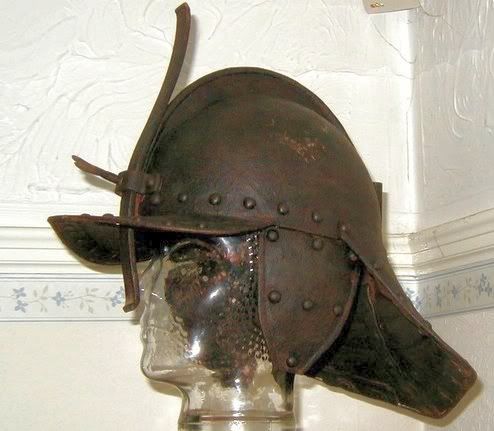
 |
|
|
|
|
#1 |
|
Member
Join Date: Sep 2008
Location: PR, USA
Posts: 679
|
It's British. We have one here at a local museum, the owner forgot it (attached head included), after one of the constant British coastal raids on the island.
Best M |
|
|

|
|
|
#2 |
|
Member
Join Date: Mar 2006
Location: Room 101, Glos. UK
Posts: 4,259
|
yes, it appears to be based on the civil war helmets of the roundhead cavalry from the english civil war,
 the q. is if it's a period one or a repro. the ones i've seen could be worn, the bill woud have been horizontal, the ear pieces hinged and tied under the chin, and the rear neck protecter would hang down the neck, and be articulated similar to a japanese samurai's to allow for some movement. these would have been worn for hours on end, marching and fighting so some balance, comfort and flexibility were required. a wall hanger would not need to be as critically made. if you can't wear it and move around in some comfort with it not trying to fall off at the slightest movement, it is likely not period, but designed to grace the walls of a victorian lord's mansion. repro's tend to be made from lighter sheet metal rather than hand forged as well. playing devil's advocate, their were lots of variants as these could also be made locally by the roundhead village smithy who was trying more to make it look like he thought it should be than the army would have liked, but as in all low bidder supply systems, it's the trooper at the end of the supply chain that gets stuck with the simplified 'variant'. here's a three-bar type, note the bill is hinged to allow it to be raised and note the ear pieces. this is a repro.  a helmet similar to post 1's. 
Last edited by kronckew; 24th September 2008 at 08:05 AM. |
|
|

|
|
|
#3 |
|
Arms Historian
Join Date: Dec 2004
Location: Route 66
Posts: 10,676
|
In looking at this most interesting helmet, though again emphasizing armour is way outside my usual field of study, I could not resist trying to find out more on these 'lobstertail' helmets. I agree that this example seems more a piece to carry the image rather than functional use. The skull seems far too shallow to securely protect the head, and the neckguard projects outward too much (though if it is correctly articulated as the Continental examples, perhaps this is shown extended). The number of lames (articulated sections) in the neckguard here is five, most German and Dutch examples have four. The lack of washers and securing guides inside the interior is apparant as noted.
The examples of these helmets from the Low Countries and Germany were apparantly imported in number just before or during the Civil Wars, according to David Blackmore in "Arms and Armour of the English Civil Wars", Royal Armouries, 1990, p.17). He also notes that many of these have 'L' or 'M' marks stamped on the nasal bar. The English versions of these helmets are as shown by Kronckew, and were called three bar pott's for the triple bar faceguard. The neckguard on these was usually comprised of simulated lames, rather than articulated as the Continental forms, as I understand. Interestingly I also discovered that these mounted troopers were known as harquebusiers, as noted by Mr. Blackmore, which is yet another fact I was entirely unaware of. Thank you for posting this interesting helmet Norman! Whether an authentic period piece or not, it is a good looking example, and certainly did compel me to look further into these, which is really why I'm here, to learn!  Thank you!!  All the best, Jim |
|
|

|
 |
|
|